The connection between emotional identity and relapse
Unraveling Emotional Identity: A Crucial Factor in Addiction Relapse

Understanding Emotional Identity in Addiction Recovery
Relapse in addiction treatment is a complex, multifaceted process often closely linked with an individual's emotional identity. This narrative explores the critical role emotional identity plays in relapse, examining underlying psychological, social, and neurological factors, and highlighting comprehensive treatment approaches designed to address these dynamics effectively.
Comprehensive Treatment Services for Addiction and Mental Health
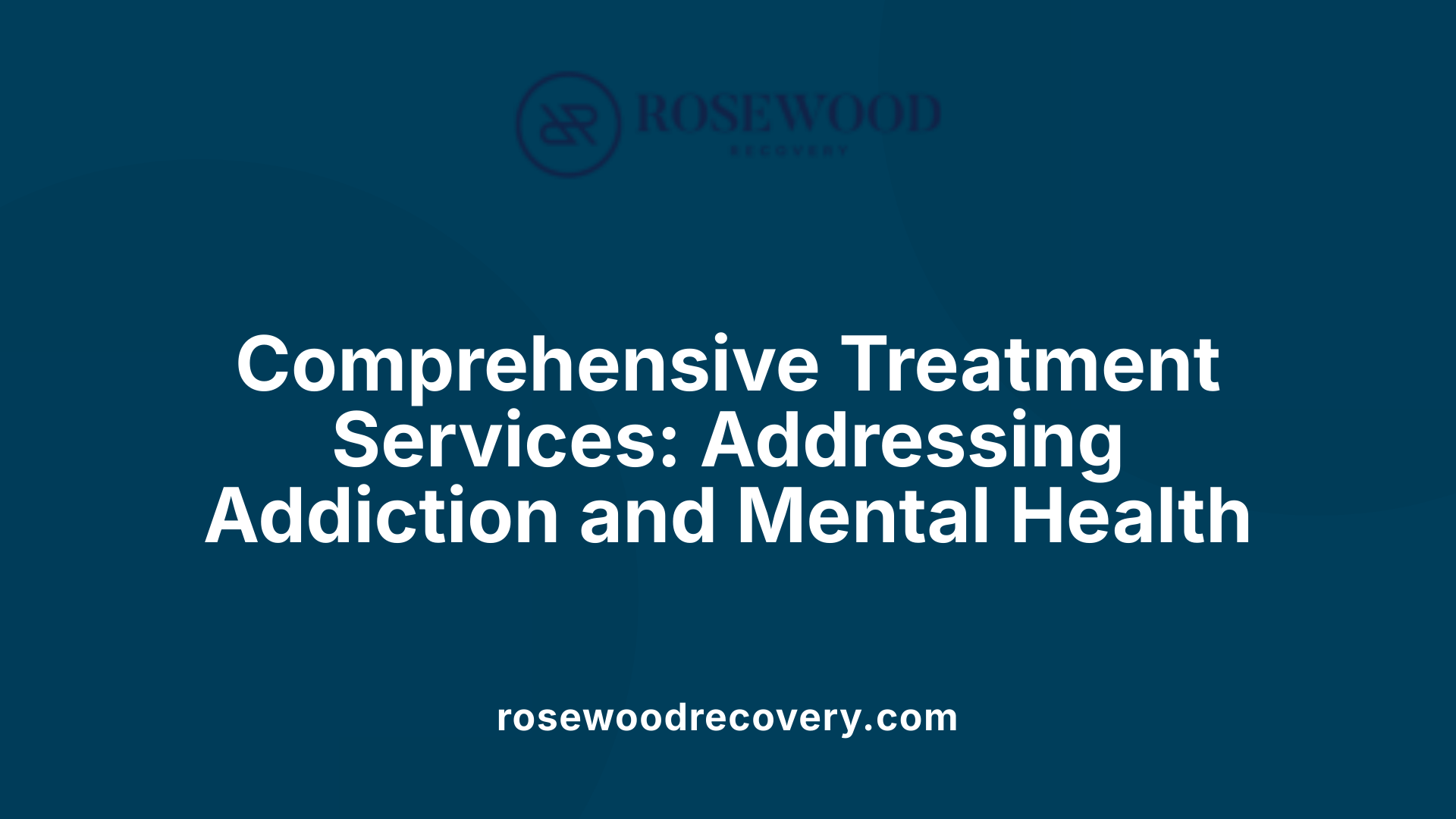
What types of treatment services are available for substance abuse and addiction?
Treatment for substance abuse and addiction includes a wide spectrum of services designed to meet diverse individual needs. These services range from outpatient and inpatient programs to detoxification, residential treatment, and medication-assisted therapies. Agencies such as SAMHSA fund extensive programs like the State and Tribal Opioid Response grants, highlighting significant investment in treatment provision.
Integrated care models addressing mental health and substance use
Integrated approaches tackle both substance use disorders and co-occurring mental health conditions, improving treatment effectiveness. SAMHSA supports comprehensive care, including online resources and helplines like the 988 Suicide & Crisis Lifeline, ensuring immediate crisis intervention. These models recognize the interconnected nature of mental health and addiction, providing coordinated therapeutic and medical support.
Role of recovery support services
Recovery support services are vital in sustaining long-term sobriety. Programs offer mentoring, coaching, and job readiness support, fostering emotional resilience and social reintegration. Campaigns such as Substance Use & Misuse Prevention Month and RecoverMe promote prevention and recovery awareness, reinforcing positive identity shifts crucial to relapse prevention.
Together, these comprehensive treatment components—medical therapies, behavioral health care, crisis services, and community support—form a robust framework addressing addiction and mental health challenges.
Addressing Mental Health Issues Within Addiction Treatment Programs
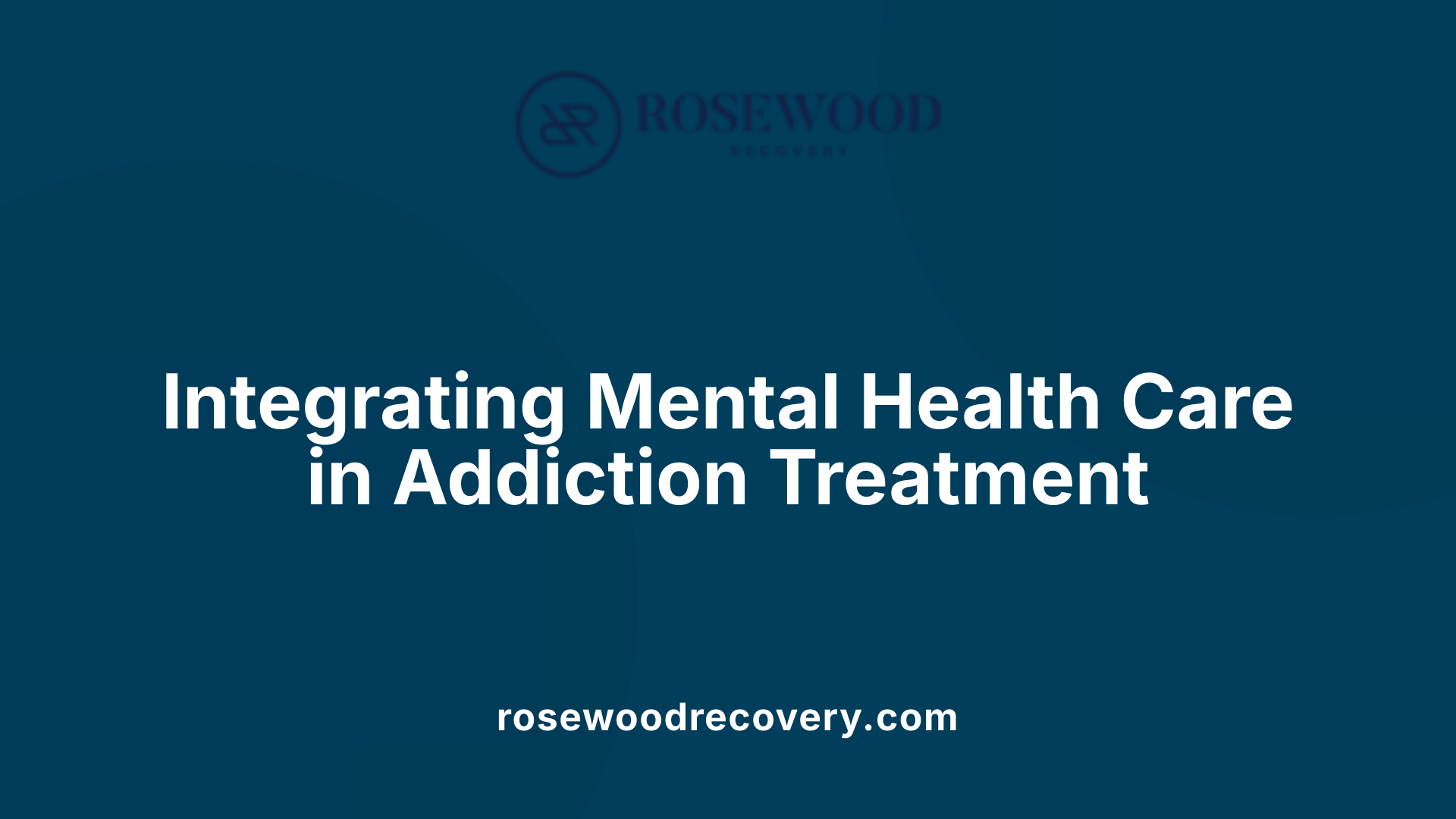
How are mental health issues addressed in addiction treatment programs?
Mental health issues in addiction treatment programs are primarily managed through integrated care models that simultaneously address substance use and co-occurring mental health disorders. This approach is essential since mental health conditions frequently coexist with substance use disorders, requiring coordinated treatment to be effective.
Therapeutic interventions commonly include cognitive-behavioral therapy (CBT), dialectical behavior therapy (DBT), and trauma-informed care. These therapies focus on emotional regulation, coping strategies, and addressing underlying trauma, which are critical for preventing relapse and promoting sustained recovery.
Programs often utilize multidisciplinary teams that combine psychiatric evaluations, medication management, and behavioral therapies. This ensures a comprehensive treatment plan tailored to each individual's unique needs.
Emergency and crisis support services play a crucial role in this integrated model. Resources such as the 988 Suicide & Crisis Lifeline and Disaster Distress Helpline provide immediate access to support during acute mental health crises. These services not only offer timely assistance but also help prevent relapse by addressing crises before they escalate.
Overall, addiction treatment programs emphasize a coordinated, evidence-based approach that blends therapy, crisis intervention, and ongoing support to effectively manage mental health issues alongside addiction.
Beyond Substance Abuse: Addressing Diverse Behavioral Addictions
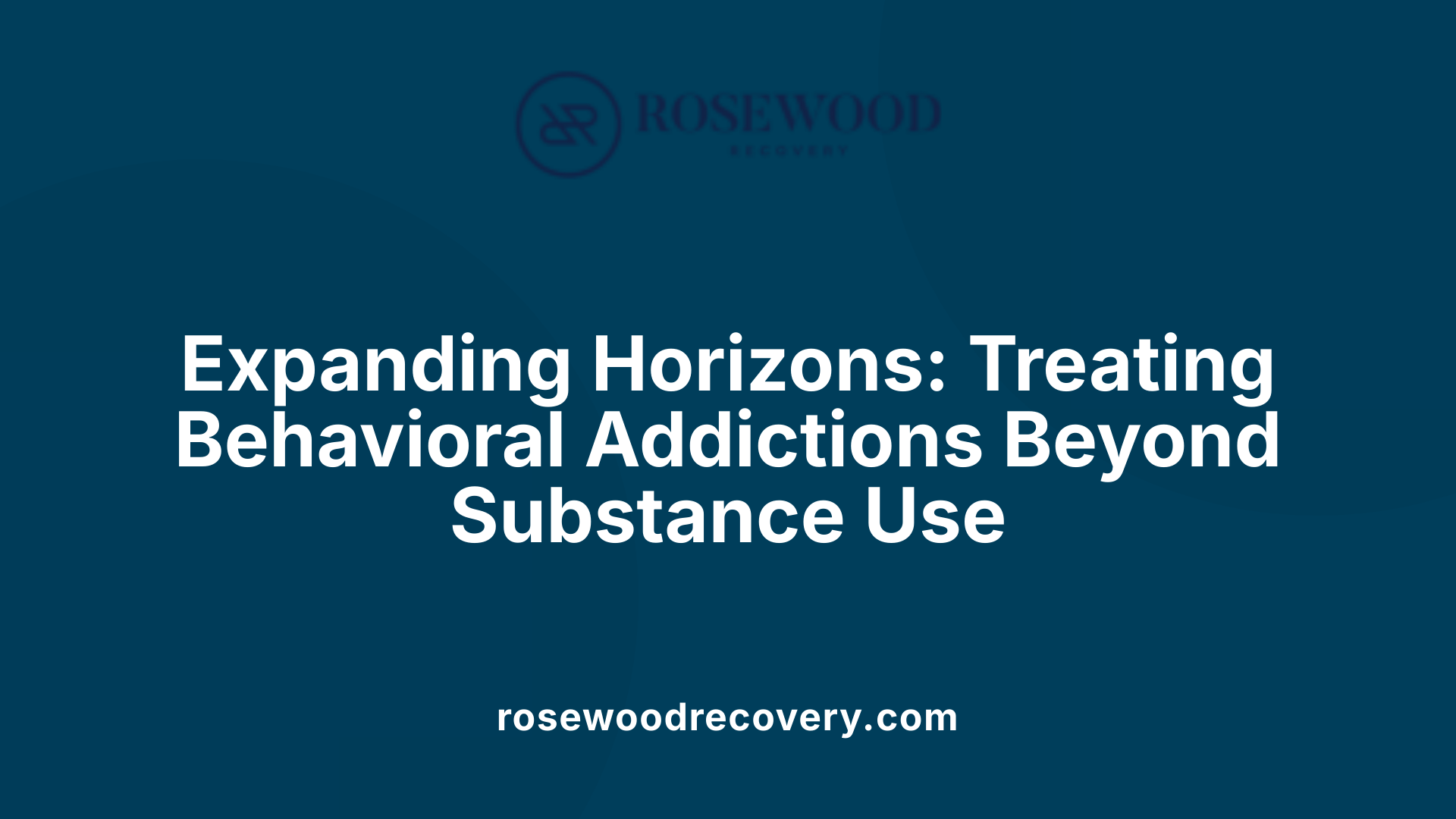
What forms of addiction can comprehensive treatment services cover beyond substance abuse?
Comprehensive treatment programs extend beyond substance use disorders to address various behavioral addictions. These include gambling disorder, internet gaming addiction, sex or pornography addiction, compulsive shopping, overeating, excessive exercise, workaholism, and smartphone addiction.
How are treatment approaches similar for substance and behavioral addictions?
Behavioral addictions share core features with substance addictions, such as compulsive engagement despite negative consequences, making their treatment approaches comparable. Cognitive-behavioral therapy (CBT) plays a central role in helping individuals recognize triggers, challenge compulsive thoughts, and develop healthier coping strategies.
Family support and mutual-help groups also provide critical social reinforcement and identification with recovery communities. In some cases, pharmacological interventions may assist in managing underlying neurobiological factors.
What roles do psychological and environmental factors play?
Psychological factors such as emotional dysregulation, stress, and negative thought patterns significantly influence behavioral addictions. Environmental triggers—like social isolation or certain situational cues—can precipitate compulsive engagement. Addressing these through tailored therapy supports relapse prevention.
Treatments recognize behavioral addictions as intertwined with neurobiological, psychological, and environmental components. This comprehensive perspective ensures interventions restore self-control, promote emotional resilience, and improve overall functioning.
Stages of Relapse: Emotional, Mental, and Physical
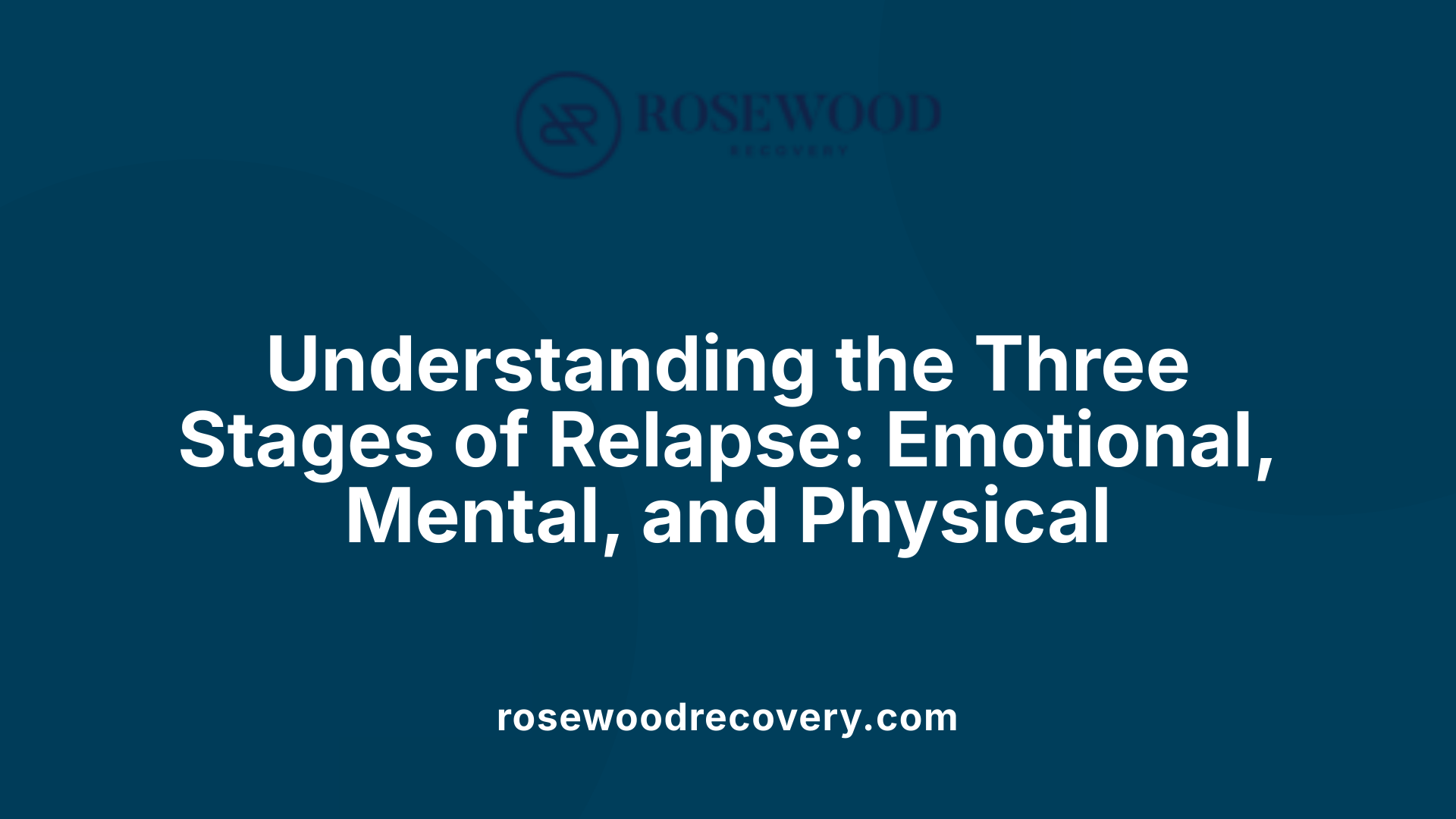
Overview of the three relapse stages
Relapse in addiction recovery is a gradual process typically divided into three distinct stages: emotional, mental, and physical relapse. Understanding these stages is crucial for effective prevention and timely intervention.
Emotional relapse
This initial stage often goes unnoticed and involves poor self-care and emotional distress. Signs include denying problems, bottling up emotions, social isolation, irregular eating and sleeping habits, feelings of exhaustion, irritability, and discontent. If these symptoms are ignored, they can escalate to mental relapse.
Mental relapse
During this phase, individuals begin to crave substances and obsess about past use. Common behaviors include minimizing the consequences of using, bargaining internally, and planning relapse scenarios. Though they may not physically relapse at this point, the risk is significantly heightened. Preventative strategies focus on helping individuals avoid high-risk situations and normalize occasional thoughts of use without acting on them.
Physical relapse
This final stage involves the actual consumption of substances. It can be preceded by a lapse—an initial slip—but is characterized by loss of control over usage.
Importance of early recognition
Early identification of emotional and mental relapse signs increases the chances of successful intervention. By addressing issues before the physical relapse, support systems and therapeutic approaches like cognitive therapy and mind-body relaxation can be employed to retrain negative thinking patterns and prevent further setbacks. Recognizing these stages empowers individuals and caregivers to act proactively in the recovery process.
Characteristics and Signs of Emotional Relapse
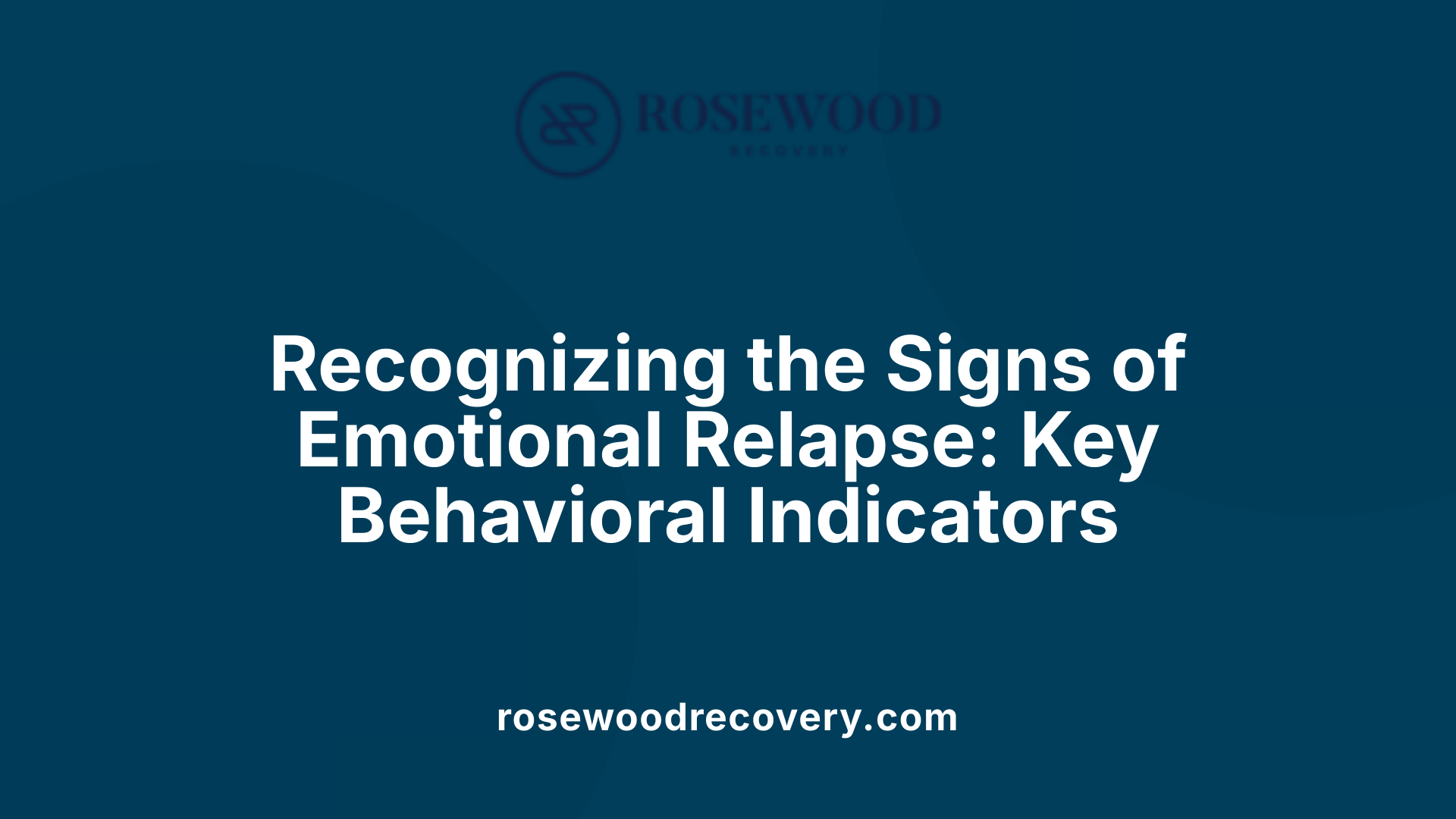
Behavioral Indicators of Emotional Relapse
Emotional relapse marks the initial stage in the process of falling back into substance use and is often subtle yet critical to identify early. Key behaviors include poor self-care habits such as neglecting hygiene, irregular sleeping and eating patterns, and denial about one’s state of recovery. Individuals may also bottle up emotions, refraining from expressing distress, which can lead to increased feelings of isolation as they withdraw from friends, family, and supportive social networks.
Common Emotional Symptoms
During emotional relapse, individuals often experience intense feelings of exhaustion, irritability, and a general sense of discontent. These symptoms might seem minor but signal the body's and mind's distress. The struggle to manage emotions effectively during this phase can dramatically lower a person’s ability to maintain sobriety.
The Risk of Progression
If emotional relapse signs are ignored or unaddressed, they tend to progress to the mental relapse stage. This progression involves more active psychological engagement with substance use thoughts, including craving, rationalization, and planning for use. Early intervention targeting emotional relapse behaviors is therefore essential to prevent advancing stages, preserving recovery progress and improving long-term outcomes.
Identifying and responding to these emotional triggers promptly through healthy coping strategies and support systems can significantly reduce the risk of relapse. Awareness and education about these signs empower individuals and their support networks to act before the relapse moves beyond the emotional stage.
Mental Relapse: Cognitive Triggers Leading to Physical Use
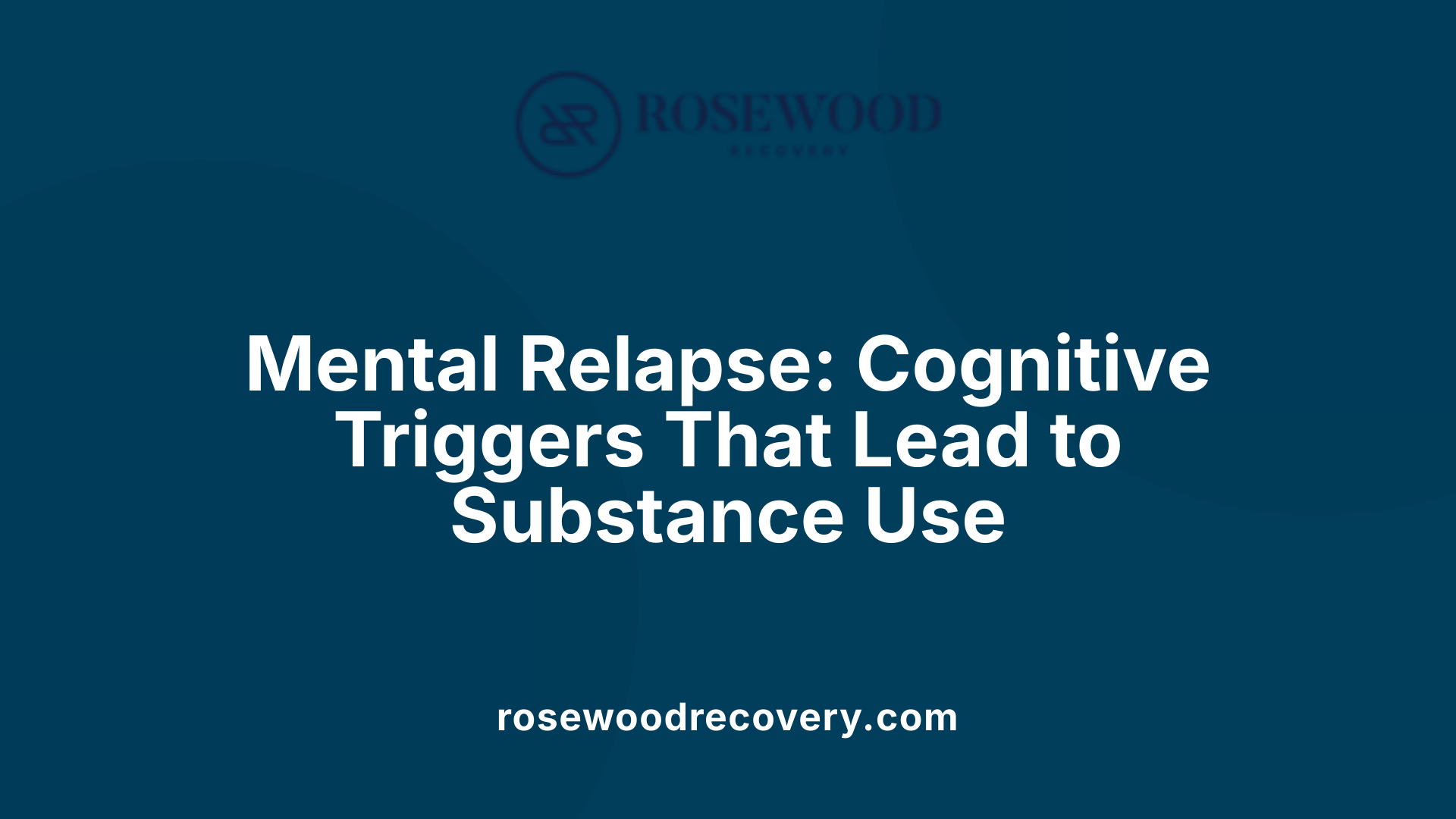
Craving and Obsessive Thinking About Substance Use
Mental relapse is distinguished by intense cravings and persistent thoughts about substance use. Individuals may find themselves repeatedly imagining the effects of the drug or alcohol, which can exacerbate feelings of temptation.
Rationalizing or Minimizing Consequences
During this stage, individuals often start to downplay the risks associated with using substances again. They may convince themselves that a single use will not cause harm, or that they can control their usage this time, ignoring past negative outcomes.
Planning and Bargaining Related to Relapse
An additional cognitive sign includes strategizing around relapse—bargaining with oneself about justifying the use or figuring out when and how to engage in substance use without getting caught or facing immediate consequences. This planning serves as a psychological preparation for a potential return to use.
Helping clients recognize these cognitive warning signs early is essential for effective relapse prevention. Normalizing occasional thoughts about using while focusing on coping strategies can empower individuals to navigate the mental challenges of recovery and avoid progressing to physical relapse.
Physical Relapse: The Return to Substance Use

Transition from Lapse to Loss of Control
Physical relapse represents the final stage in the relapse continuum, marked by the actual use of substances. This stage often follows an initial lapse—a single or brief return to substance use—that, if unmanaged, can escalate into full relapse characterized by a loss of control over consumption. This progression underscores the fragile boundary between a lapse and a more severe physical relapse.
Physical Use as the Final Relapse Stage
Unlike emotional and mental relapse, which involve internal processes such as denial and cravings, physical relapse is the tangible manifestation of relapse through substance use. It signals the breakdown of earlier coping mechanisms and the resurfacing of addictive behaviors. Recognizing this stage is crucial since it is the most visible and arguably the most dangerous phase.
Consequences and Need for Immediate Intervention
The consequences of physical relapse can be severe, ranging from health deterioration to psychological distress and increased risk of overdose. Immediate intervention is critical to manage withdrawal, re-engage individuals in treatment, and prevent further use. Effective relapse prevention strategies include cognitive therapy, mind-body relaxation techniques, and reinforcing the five rules of recovery: lifestyle changes, honesty, help-seeking, self-care, and adherence to recovery principles. Prompt action when physical use occurs can substantially improve long-term recovery outcomes.
Prevention Through Behavioral and Cognitive Strategies

Role of cognitive therapy in relapse prevention
Cognitive therapy plays a crucial role in relapse prevention by helping individuals recognize and change negative thinking patterns that may lead to substance use. It focuses on retraining neural circuits to reduce harmful thought processes such as all-or-nothing thinking and catastrophizing, which are common contributors to relapse.
Mind-body relaxation techniques
In addition to cognitive therapy, mind-body relaxation techniques are effective tools for maintaining recovery. These approaches, including practices such as meditation, deep breathing, and progressive muscle relaxation, help reduce stress and anxiety. Managing emotional triggers through these methods supports emotional regulation, reducing the risk of relapse.
Changing negative thinking patterns to support recovery
Recovering individuals often struggle with distorted thinking that undermines their progress. Behavioral strategies guide clients to identify these harmful thoughts and replace them with more balanced, constructive ones. This shift not only improves emotional well-being but also strengthens resilience against cravings and relapse triggers.
Together, cognitive therapy and mind-body relaxation provide complementary strategies that target both thought and physiological responses, promoting sustained recovery and reducing relapse risk.
Negative Thinking Patterns and Their Impact on Relapse
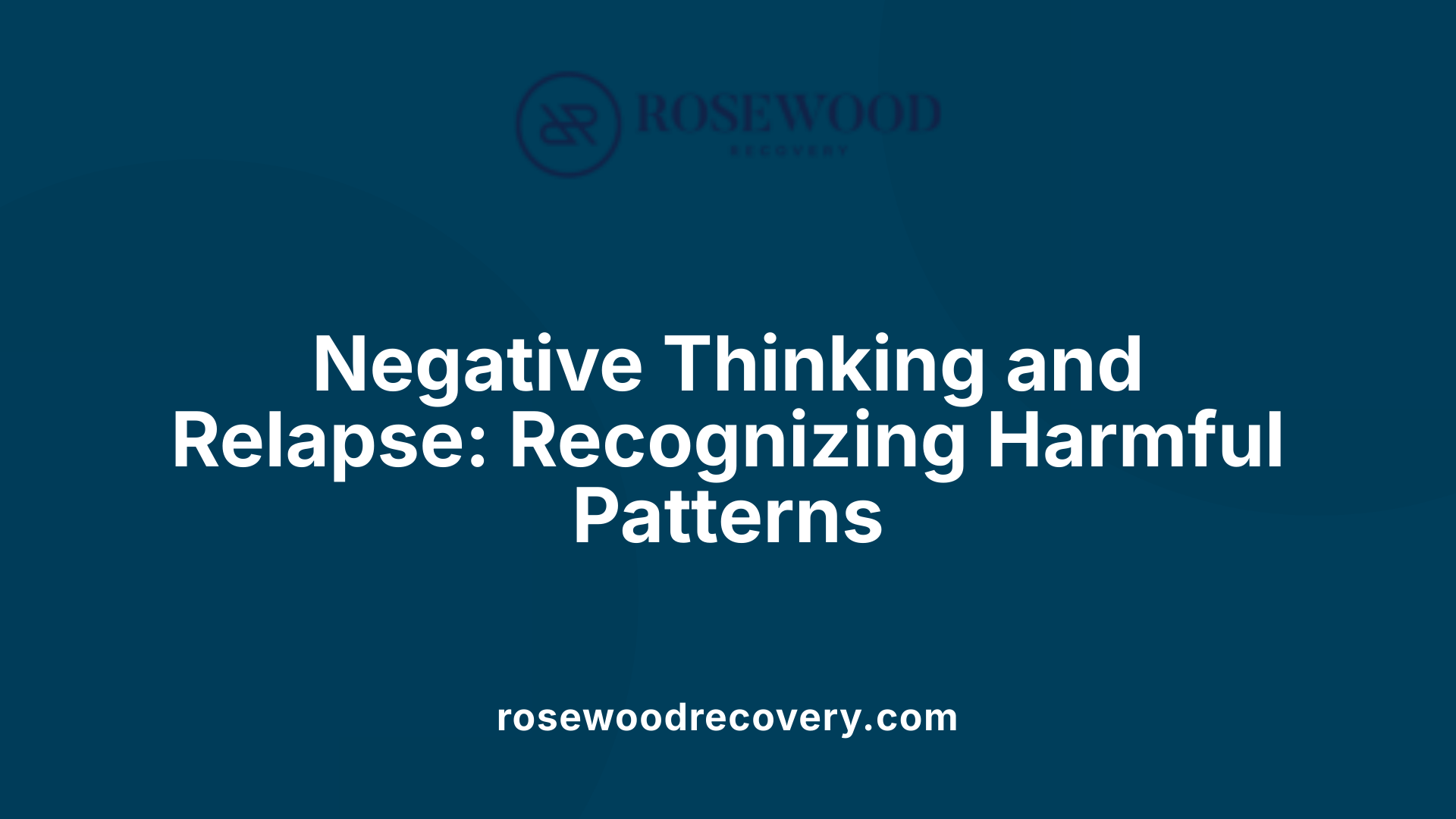
All-or-nothing thinking
All-or-nothing thinking, also known as black-and-white thinking, is a cognitive distortion where individuals see situations in absolute terms—either all good or all bad. In addiction recovery, this pattern can lead to harmful beliefs such as "I have to be perfect in recovery or I’m a failure." Such rigid thinking often undermines motivation and resilience, increasing vulnerability to relapse by making setbacks feel catastrophic.
Catastrophizing and distorted cognition
Catastrophizing involves anticipating the worst possible outcomes, amplifying the perceived threat of cravings or triggers. This distorted cognition can intensify feelings of anxiety, hopelessness, and helplessness. For example, a person might think, "If I feel a craving, I will definitely relapse and ruin everything," which fuels despair and defeatism. These negative thought patterns contribute significantly to the emotional relapse stage, where poor emotional regulation increases risk.
How cognitive therapy retrains neural circuits for healthier thoughts
Cognitive therapy plays a crucial role in relapse prevention by helping individuals identify and challenge these distorted thinking patterns. Through structured exercises and therapeutic dialogue, clients learn to replace all-or-nothing and catastrophic thoughts with balanced, realistic perspectives. This process retrains neural circuits to support healthier cognitive and emotional responses.
By transforming negative patterns, cognitive therapy strengthens emotional regulation and reduces cravings, directly targeting the brain regions implicated in relapse risk such as the prefrontal cortex and amygdala. It empowers individuals to manage triggers with better coping strategies, fostering sustainable recovery and reducing relapse chances.
The Five Rules of Recovery: Practical Guidelines Against Relapse
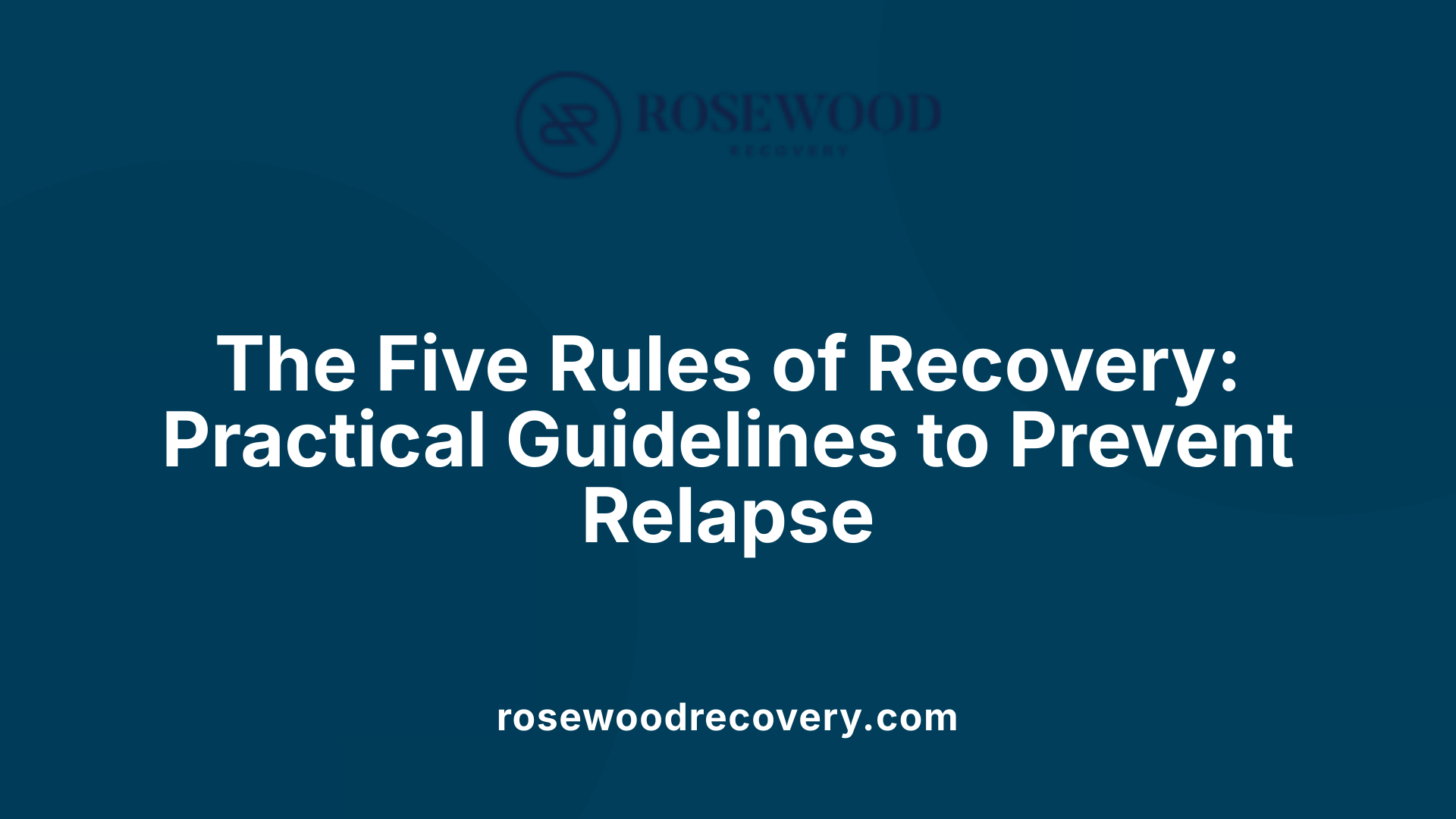
Life Changes to Support Sobriety
Sustaining recovery from addiction requires significant lifestyle adjustments. The first rule, "change your life," emphasizes adopting new routines and environments that support sobriety. This could include avoiding former social circles that encouraged substance use and establishing healthier daily habits.
Honesty and Self-Care Importance
Being truthful with oneself and others is crucial during recovery. The second rule, "be honest," encourages individuals to acknowledge their struggles and progress openly. Coupled with this is the fourth rule, "practice self-care," which highlights the need for taking care of one’s physical and emotional well-being through activities such as proper nutrition, rest, and stress management.
Seeking Help and Maintaining Integrity in Recovery
No one recovers alone, which makes the third rule, "ask for help," essential. Support from counselors, support groups, or trusted friends aids in navigating challenges and coping with triggers. The final rule, "don’t bend the rules," reminds recovering individuals to maintain personal integrity by adhering strictly to their recovery commitments and avoiding rationalizations that may lead to relapse.
Together, these five practical guidelines serve as a roadmap for those aiming to prevent relapse by fostering resilience, accountability, and continuous support throughout their recovery journey.
Recovery Identity and Professional Commitment Among Counselors
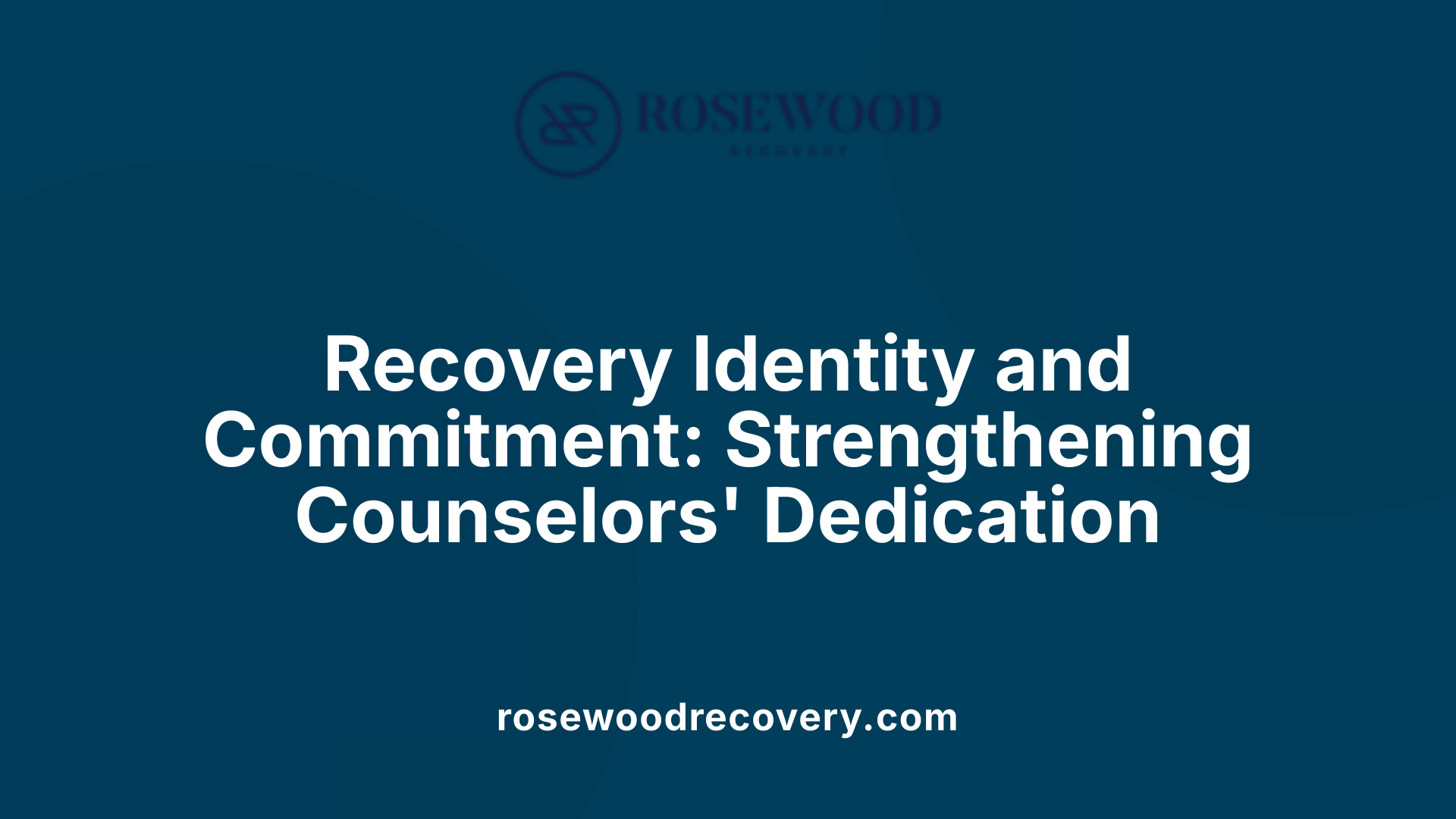
How Does Recovery Status Impact Substance Abuse Counselors?
A large-scale study involving 695 substance abuse treatment counselors across the United States reveals compelling insights into counselor identity. A significant portion—ranging from 37% to 57%—of counselors report being in recovery from addiction themselves. This personal recovery status notably correlates with higher affective professional commitment, meaning these counselors demonstrate a stronger emotional attachment and identification with their profession.
What Does Social Identity Theory Say About Professional Commitment?
Social identity theory suggests that belonging to social groups shapes individuals' self-concept and behavior. In this context, the recovery identity stemming from group memberships, such as participation in support networks like Alcoholics Anonymous, fosters a robust professional identity for counselors in recovery. This identity positively influences their motivation and dedication to their counseling role, embedding recovery experience as a meaningful professional resource.
How Do Professional and Organizational Commitment Differ in This Context?
Interestingly, the same study finds no significant relationship between recovery status and organizational commitment. This distinction highlights that while counselors in recovery strongly identify with and are committed to the substance abuse counseling profession itself, this does not extend necessarily to commitment to their employing organizations. Thus, personal recovery experience strengthens professional identity more than organizational allegiance.
This differentiation underscores the importance of considering personal recovery as a powerful factor enhancing counselors' affective commitment to their work, independent from workplace dynamics. Integrating these insights can enhance recruitment, retention, and support strategies for substance abuse professionals who draw on their lived experience to aid others.
Social Identity Theory and Its Role in Addiction and Recovery
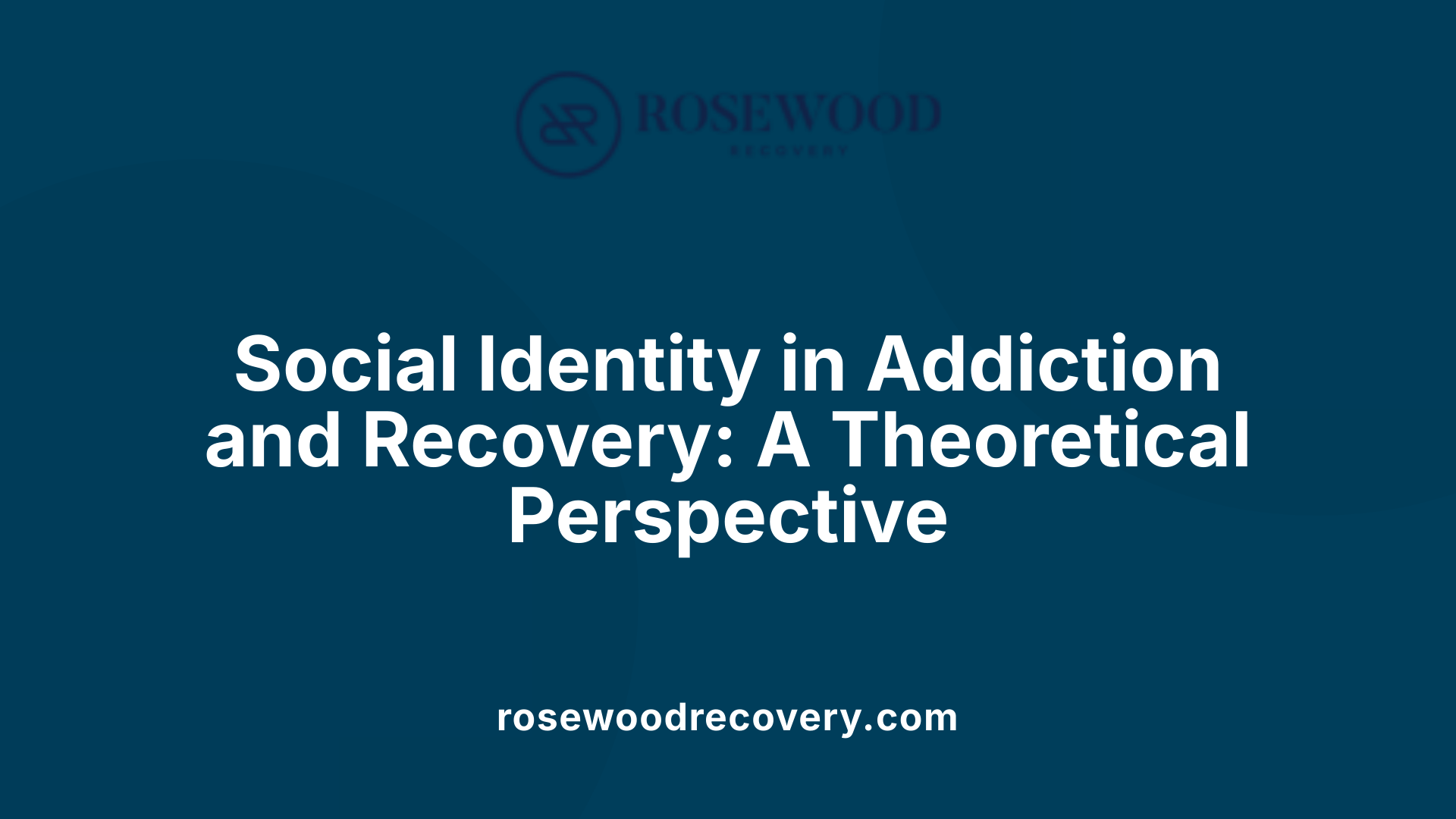
How does social identity influence addiction and recovery?
Social identity theory explains that a person's self-concept is shaped by their membership in social groups. In the context of addiction and recovery, this means that individuals identify themselves through their association with groups such as recovery communities or substance-using networks. These group memberships significantly influence behavior and motivation.
Why is identity important for commitment to recovery?
A counselor’s or a person's personal recovery status forms a recovery identity through social group memberships like Alcoholics Anonymous. This identity acts as a powerful motivator, enhancing affective professional commitment for counselors and boosting the individual's commitment to maintain sobriety. The recovery identity strengthens motivation because it connects the person to a community that supports abstinence, fosters a sense of belonging, and reinforces positive behavioral norms.
How do recovery groups help reinforce a sober identity?
Participation in structured recovery groups such as AA or Narcotics Anonymous provides normative structures around abstinence and offers active roles that help maintain a sober identity. These groups offer social support, shared goals, and group norms that encourage continuous engagement in recovery efforts. By fostering a recovery-based social identity, group members are better equipped to resist relapse and sustain long-term recovery.
In summary, social identity theory reveals that embracing a recovery identity through supportive groups plays a central role in sustaining motivation and commitment during addiction recovery. This social framework helps individuals rebuild positive identities and facilitates behavioral change essential to preventing relapse.
Social Factors Impacting Addiction and Recovery Pathways
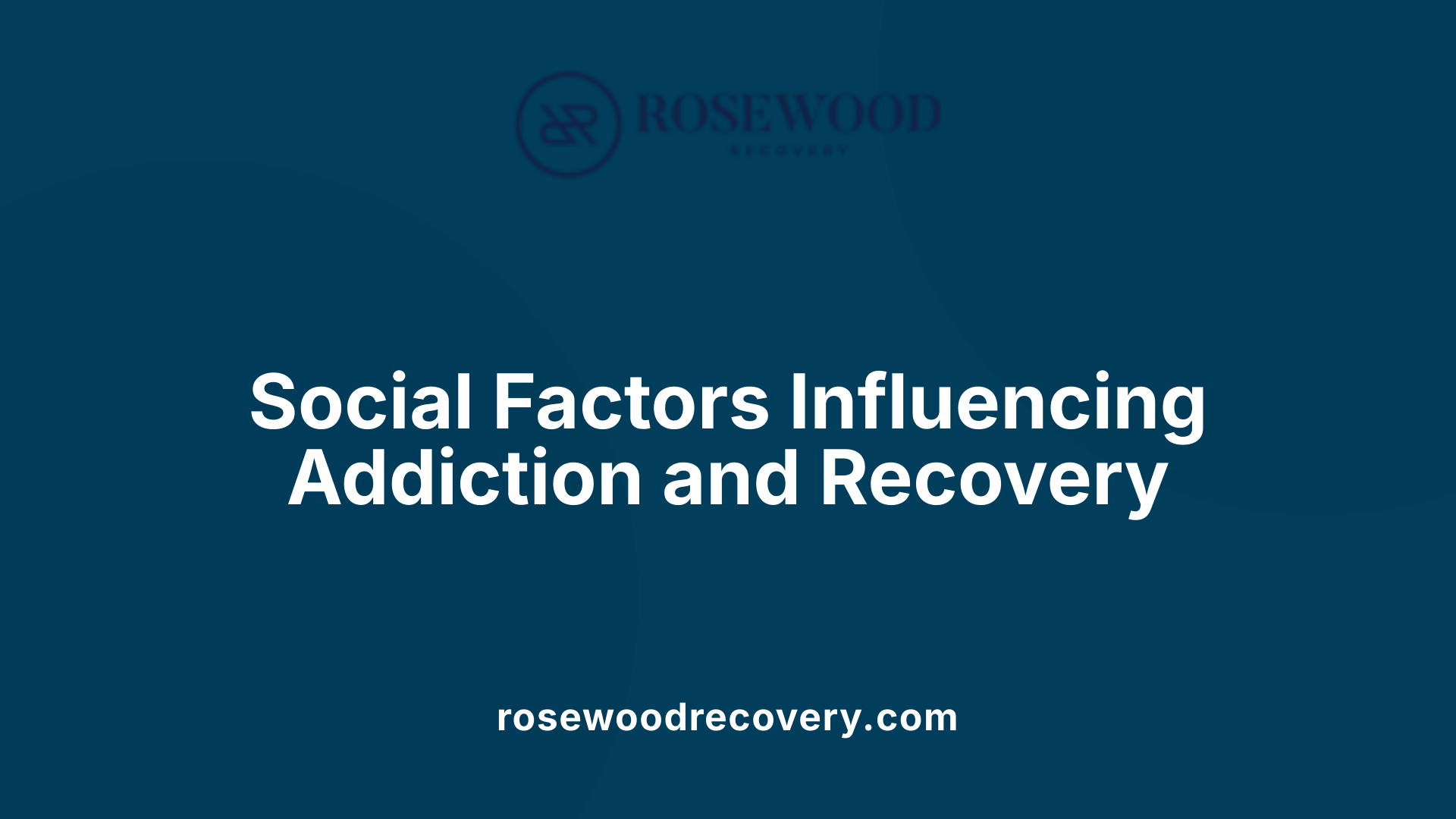
Role of social isolation and social network support
Social factors play a pivotal role throughout substance use disorder (SUD) stages, including onset, progression, treatment, and recovery. Social isolation often exacerbates addiction risks by depriving individuals of emotional support and positive social cues. In contrast, strong social network support—such as peer encouragement and community belonging—acts as a protective factor that can reduce relapse risk and promote sustained recovery.
Two distinct identity-related pathways into addiction
Research identifies two diverse addiction pathways based on identity dynamics. The first pathway involves the loss of positive social identities, such as family roles or employment, which leads to increased vulnerability to substance use. The second pathway reflects addiction as a form of identity gain for individuals who experience social isolation or marginalization. Understanding these identity-based trajectories helps tailor treatment approaches by recognizing different motivational and social needs.
Renewal of lost positive identities during treatment
A crucial component during addiction treatment is the process of identity transformation. Many participants attempt to reclaim or rebuild positive identities that were lost or damaged during substance use, such as being a supportive family member, student, or employee. Others develop new aspirational identities post-treatment, which provide motivation and structure for sustained recovery. This renewal or formation of constructive social identities supports emotional resilience and helps buffer against relapse.
These findings highlight the importance of incorporating social identity perspectives into addiction treatment planning, emphasizing the role of belonging and identity renewal in fostering long-term recovery success.
Support Groups and Community Involvement in Relapse Prevention
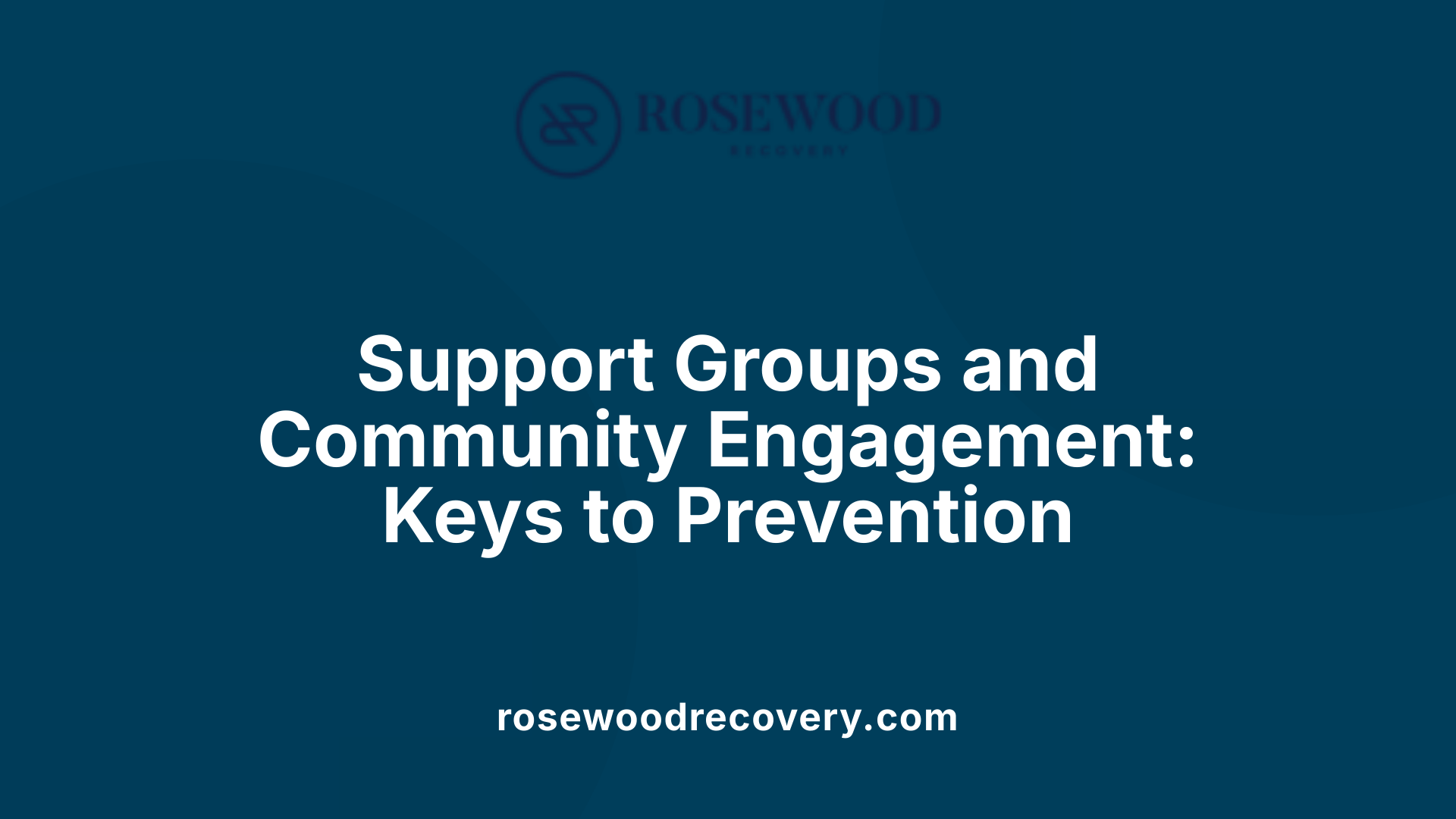
Benefits of participation in AA and Narcotics Anonymous
Participation in Alcoholics Anonymous (AA) and Narcotics Anonymous (NA) offers vital benefits for individuals recovering from substance use disorders. These groups provide structured support environments where members can share experiences, gain encouragement, and develop coping skills. Such involvement fosters a sense of belonging and identity aligned with recovery, which is crucial for sustaining long-term abstinence.
Normative group influence supporting abstinence
Support groups establish clear norms centered around abstinence and healthy living. This normative influence helps members internalize recovery behaviors and reject substance use. By regularly engaging with peers who prioritize sobriety, individuals reinforce their commitment to recovery, reducing the risk of relapse. The social identity formed within these groups acts as a protective factor by promoting accountability and shared values.
Active roles in recovery communities and reduced relapse rates
Taking on active roles in AA or NA—for example, as sponsors or meeting facilitators—enhances a person’s professional and personal recovery identity. These roles boost self-efficacy and provide purpose, which are linked to lower relapse rates. Active participation encourages continued involvement and deeper connections that strengthen resilience against triggers and cravings.
In summary, support groups like AA and NA play a critical community role by providing social support, reinforcing abstinent norms, and encouraging active recovery engagement. These factors collectively contribute to reduced relapse risk and promote sustained recovery success.
Longitudinal Perspective on Identity Change in Addiction Recovery
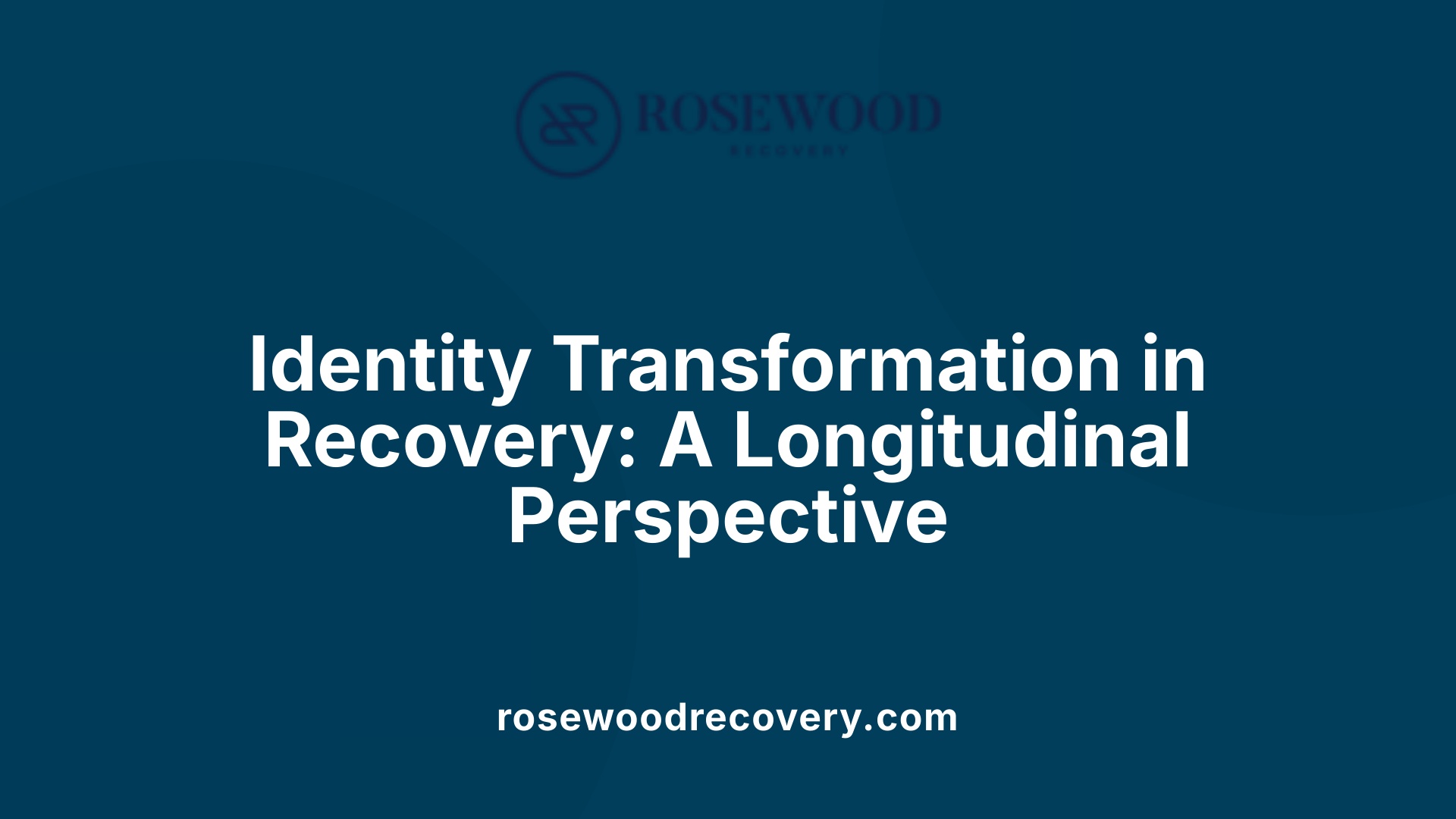
Identity Shifts Over Time in Recovery
Longitudinal studies have revealed that identity transformation is a fundamental component in the addiction recovery process. Individuals in recovery often experience profound shifts in their self-concept, moving from an addiction-centered identity to new, positive social identities. Some patients work to renew identities lost during active substance use, such as family roles or career aspirations, while others adopt completely new aspirational roles related to education or work. This evolution in identity plays a critical role in motivating sustained recovery and reducing relapse risk.
Qualitative Evidence Supporting Identity Transformation Models
Qualitative, longitudinal research offers rich insight into these identity changes. By tracking individuals over time, these studies illuminate how identity shifts correspond with recovery milestones. For example, participation in structured support groups like Alcoholics Anonymous not only helps maintain abstinence but also reinforces a collective recovery identity that supports social belonging and adherence to recovery norms. Such evidence underscores the importance of social identity processes, including group memberships and peer support, in fostering long-term recovery success.
Future Research Implications for Addiction Treatment
The novel longitudinal approach to studying identity transformation suggests several promising directions for addiction research and treatment. Future studies could expand on these models to develop personalized interventions that actively facilitate identity reconstruction. Additionally, integrating identity-based strategies into therapy could enhance motivation and resilience. Continued investigation into how identity change interacts with neurocognitive and emotional regulation processes holds potential for creating more comprehensive, effective addiction treatments.
Baseline Substance Use and Its Predictive Role in Relapse
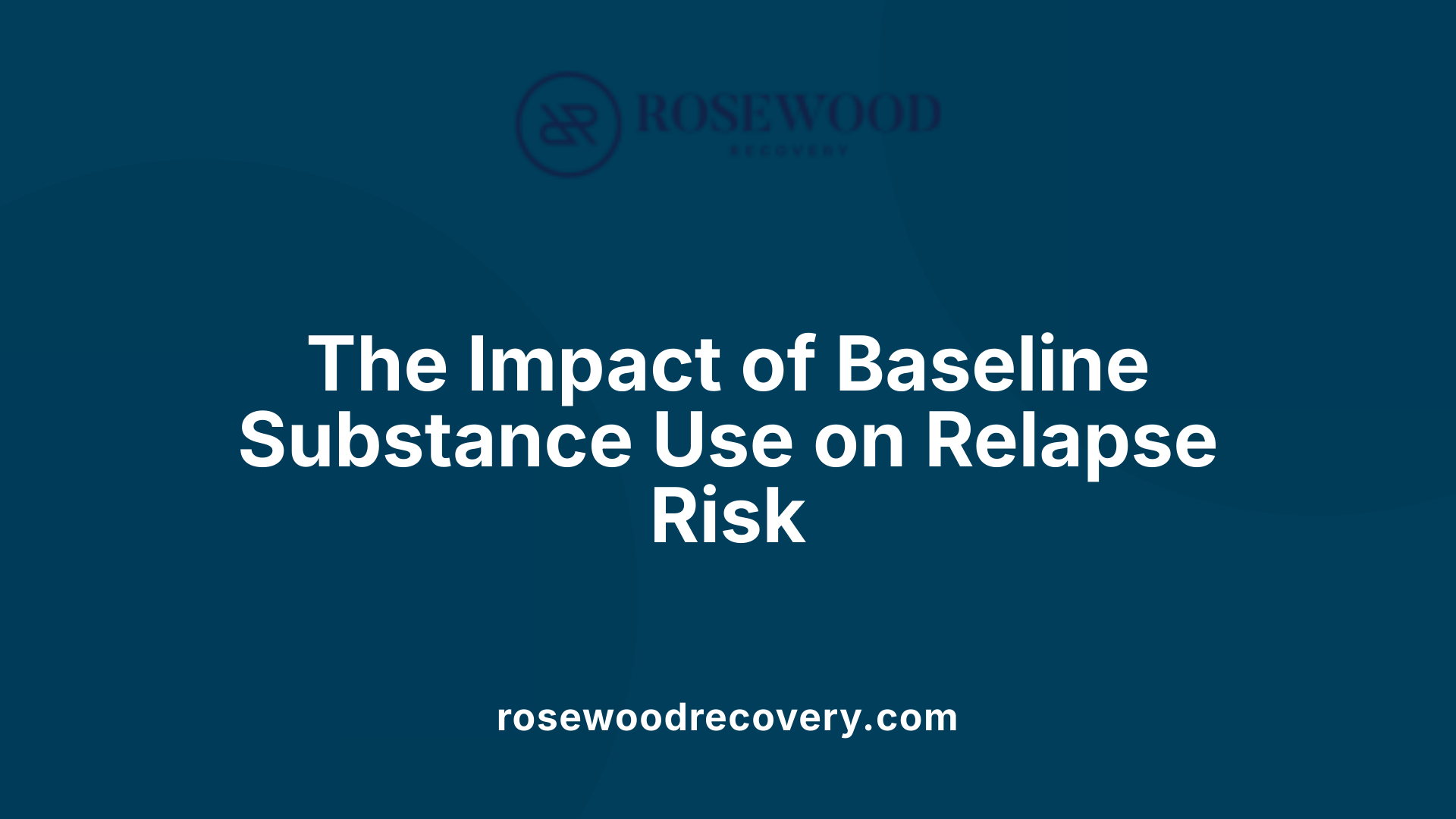
How does the severity of substance use at treatment entry impact relapse risk?
Research consistently shows that baseline substance use—referring to the frequency and amount of drug use when a patient begins treatment—is a crucial predictor of relapse. Patients who enter treatment with higher levels of substance use are more prone to relapse compared to those with lower baseline consumption. This relationship highlights the importance of early and accurate assessment of substance use severity as a core step in effective treatment planning.
What is the association between initial use levels and relapse risk?
Studies reveal that more severe initial substance use increases the likelihood of returning to drug use post-treatment. This predictive value holds particularly for opioid use disorders and possibly stimulants, underscoring the elevated risk these substances pose. Recognizing this association helps healthcare providers anticipate challenges patients may face during recovery and tailor interventions accordingly.
Why is understanding baseline substance use critical for relapse risk assessment and treatment planning?
By evaluating baseline use severity, clinicians can better stratify patients' relapse risk, designing customized care plans that address individual needs. This approach enables early intervention strategies aimed at reducing triggers linked to heavier substance use and incorporating relapse prevention methods such as cognitive therapies and emotional regulation training. Ultimately, integrating baseline substance use information into treatment assessment enhances the chances of sustained recovery and reduces relapse rates.
Psychological Factors Predicting Relapse: Craving and Attention Issues

Craving Intensity as a Predictor of Relapse
Craving is a powerful psychological factor that significantly predicts relapse in substance use disorders. It comprises intense urges or desires to use substances that can overwhelm an individual's self-control. Studies reveal that higher craving intensity correlates with an increased likelihood of returning to drug use, especially opioids and stimulants. Craving often arises during the mental relapse stage, manifesting as persistent thinking about past substance use and planning future use.
Role of Attention Problems in Relapse Vulnerability
Attention difficulties also play a crucial role in relapse. Problems with concentration, distractibility, and impaired cognitive control can increase susceptibility by reducing the ability to manage triggers and resist cravings. Individuals with attention deficits may struggle to maintain the focus necessary for coping strategies and relapse prevention behaviors. This cognitive vulnerability can make it harder to navigate high-risk situations and adhere to treatment plans.
Heterogeneity of Psychological Relapse Predictors
Research indicates that psychological predictors for relapse are highly heterogeneous and complex. Beyond craving and attention problems, other psychological factors vary widely across individuals and studies, presenting challenges for consistent prediction. Factors such as mood states, stress levels, and psychiatric diagnoses show inconsistent relationships with relapse. The moderate to high bias in existing studies highlights the need for more rigorous, standardized research to disentangle these variables.
Collectively, craving intensity and attention problems are among the few psychological factors with some predictive value for relapse. Their identification underscores the importance of including cognitive and emotional assessments in treatment planning. Integrating techniques like cognitive therapy and mindfulness to address these vulnerabilities can improve relapse prevention outcomes by strengthening mental resilience and coping capacity.
Mental Health Diagnoses and Their Limited Predictive Value for Relapse

Lack of Evidence Linking Psychiatric Diagnoses to Relapse Risk
Current research indicates that psychiatric diagnoses alone do not consistently predict relapse in substance use disorders. Studies have shown that while mental health conditions are important clinical considerations, they do not independently determine the likelihood of an individual returning to substance use after treatment.
Complexity in Predicting Relapse Based on Mental Health Status Alone
Relapse is a multifaceted process influenced by a variety of factors including initial substance use severity, psychological craving, attention deficits, and social circumstances. The heterogeneity in study designs and patient populations further complicates establishing a direct link between mental health diagnoses and relapse risk. This complexity suggests that mental health status, although relevant, is insufficient on its own to forecast relapse.
Need for Multi-Factorial Approaches in Relapse Prediction
Effective relapse prediction requires integrating multiple factors beyond mental health diagnoses. These include baseline substance use patterns, psychological and cognitive indicators, social identity shifts, and environmental triggers. A comprehensive approach leveraging diverse data sources and behavioral health metrics will better capture the dynamic nature of relapse risk and support targeted intervention strategies.
Brain Regions Involved in Emotional Processing and Addiction

Altered Activity in Amygdala, Insula, ACC, and Prefrontal Cortex
Neuroimaging studies consistently reveal that addiction is associated with significant alterations in brain regions responsible for emotional regulation and processing. Key areas include the amygdala, insula, anterior cingulate cortex (ACC), and prefrontal cortex. These regions play vital roles in interpreting emotional cues, managing stress responses, and controlling impulses—functions often impaired in individuals struggling with addiction.
Differences Observed Across Substances
Research highlights substance-specific patterns of brain activity alteration:
Alcohol Dependence: There is notably blunted activation in response to negative emotional stimuli in the ACC, insula, fusiform gyrus, hippocampus, orbitofrontal cortex (OFC), and amygdala. This blunting impairs emotional recognition and regulation, potentially increasing vulnerability to relapse.
Cocaine Dependence: Studies show increased activation in the dorsolateral prefrontal cortex (dlPFC) during emotional reappraisal tasks, alongside heightened responses in the insula, ACC, hippocampus, and amygdala during stress imagery. These findings suggest heightened emotional sensitivity or dysregulation.
Opioid Dependence: Neuroimaging reveals amygdala hyperactivity when processing fearful faces, coupled with increased amygdala-cortical connectivity linked to anxiety. This hyperactivity can be mitigated by opioid treatment.
Neural Correlates of Emotional Dysregulation in Relapse
Alterations in these brain regions contribute to emotional dysregulation, a key factor in relapse. Dysfunctional processing in the amygdala and ACC may impair the ability to cope with stress and negative emotions, while insula involvement influences craving and interoceptive awareness. Changes in prefrontal cortex activity undermine decision-making and impulse control, increasing relapse risk.
Ongoing research emphasizes the necessity for standardized neuroimaging protocols and the exploration of interventions like brain stimulation to normalize these neural circuits, aiming to improve emotional regulation and addiction treatment outcomes.
Implications of Neuroimaging Findings for Treatment Innovation

Need for standardized neuroimaging tasks
Current neuroimaging research in addiction reveals altered activity and connectivity in brain regions linked to emotional regulation, such as the amygdala, insula, anterior cingulate cortex (ACC), and prefrontal cortex. However, studies vary widely in their methodology and terminology, limiting the comparability of findings across substances like alcohol, cocaine, opioids, and cannabis. Standardizing neuroimaging tasks and protocols is crucial to reliably detect patterns of brain activation and dysfunction associated with relapse risk and emotional dysregulation.
Potential interventions like brain stimulation
Emerging evidence suggests that interventions targeting dysregulated neural circuits hold promise for improving treatment outcomes. Brain stimulation techniques, including transcranial magnetic stimulation (TMS) and transcranial direct current stimulation (tDCS), aim to modulate activity in critical regions implicated in addiction. By recalibrating neural pathways involved in craving, stress response, and emotional processing, these approaches could reduce relapse vulnerability.
Goal of modulating dysregulated neural circuits to improve outcomes
The overarching objective is to develop therapies that restore balanced functioning within the brain's emotional and cognitive control networks. Such modulation could attenuate hyper-responsiveness to triggers and negative emotions, enhancing patients' ability to maintain abstinence. Integrating neuroimaging-guided interventions with cognitive-behavioral therapies may enable personalized, mechanism-based treatment strategies, augmenting long-term recovery prospects.
Triggers in Recovery: Emotional, Environmental, and Social Influences

Classification and Examples of Relapse Triggers
Relapse triggers during recovery are varied and can be broadly categorized into emotional, environmental, and social types. Emotional triggers often include stress, negative emotions, and feelings of loneliness or anger. Environmental triggers might be specific places where substance use previously occurred or objects linked to past use. Social triggers encompass certain interactions or relationships that may prompt cravings or relapse.
Role of Internal and External Cues
Triggers may arise internally or externally. Internal cues involve feelings, thoughts, or physiological states such as craving or emotional distress. External cues are typically people, locations, or visual reminders associated with previous substance use. Visual cues, often subconscious, can activate cravings and drive relapse behavior without full awareness.
Impact of Unmet Basic Needs Using the HALT Acronym
The HALT acronym (Hungry, Angry, Lonely, Tired) highlights basic unmet needs that increase vulnerability to relapse. For instance, being hungry or tired can intensify emotional distress, while feelings of anger or loneliness may exacerbate cravings. Awareness of these states is critical to coping effectively and preventing relapse by addressing core needs promptly.
Healthy Coping Strategies to Manage Relapse Triggers
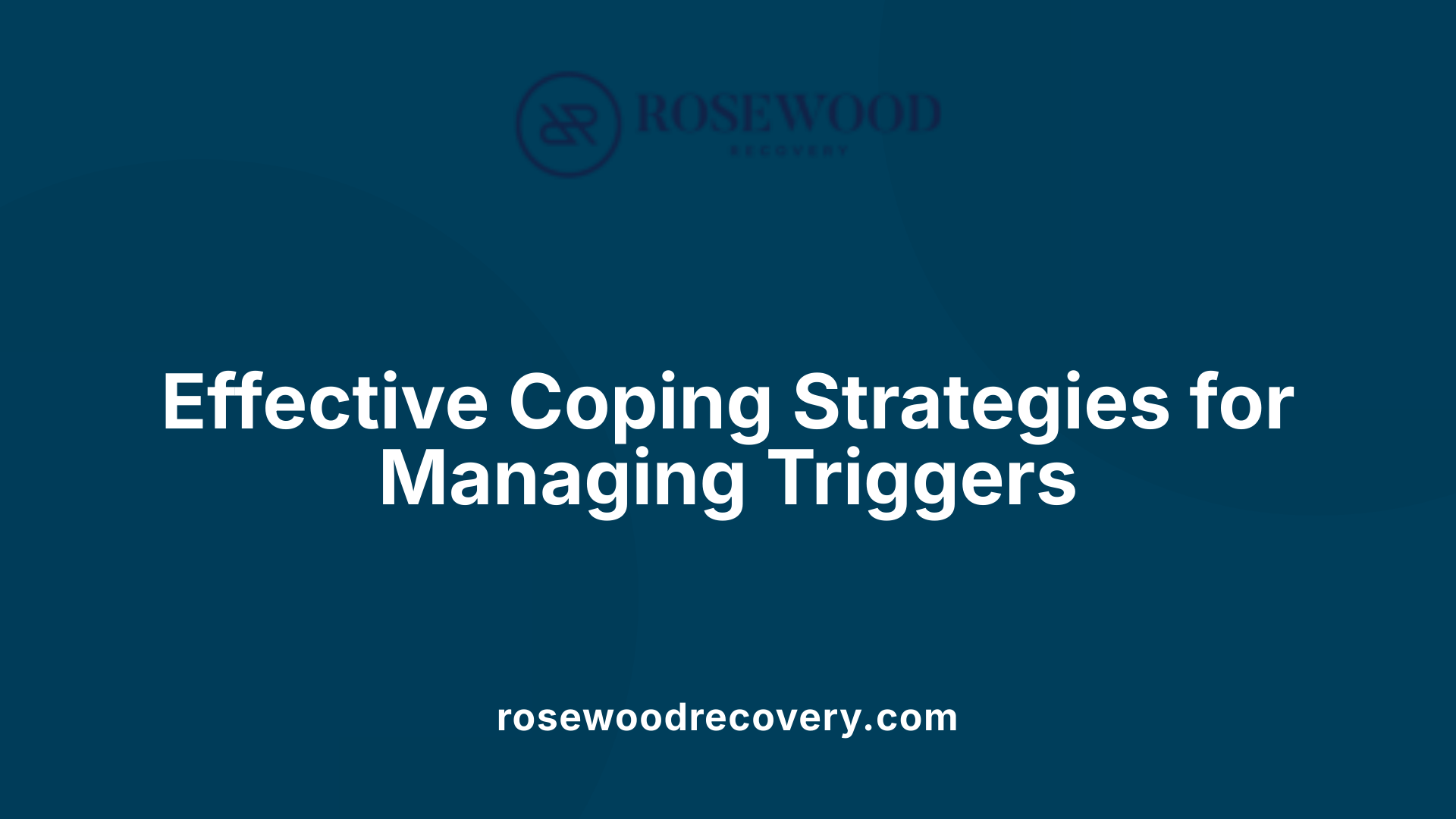
Why Are Support Systems Important in Recovery?
Support systems play a crucial role in managing relapse triggers and maintaining recovery. Staying connected with friends, family, counselors, or support groups provides emotional encouragement and accountability. These connections help individuals feel understood and less isolated, making it easier to cope with cravings or emotional distress.
How Can Distraction Techniques Help?
Distraction techniques redirect attention away from cravings or stressful triggers. Activities such as engaging in hobbies, exercising, or spending time in nature can effectively interrupt negative thought patterns. These distractions reduce the intensity of urges and provide healthier outlets for managing stress or boredom.
What Role Does Positive Self-Talk Play in Preventing Relapse?
Positive self-talk involves consciously replacing negative or catastrophic thoughts with encouraging and rational statements. This practice builds resilience and helps retrain the brain’s response to triggers. For example, reminding oneself of past successes or the reasons for recovery can reinforce commitment and reduce relapse risk.
How Does Relaxation Support Recovery?
Relaxation methods like deep breathing, meditation, or progressive muscle relaxation help reduce physical and emotional tension. Lowering stress levels improves emotional regulation, which is essential during moments of vulnerability to relapse. Regular practice of relaxation techniques can strengthen coping skills over time.
What Other Strategies Can Help Maintain Recovery?
Maintaining a balanced lifestyle that emphasizes self-care—such as regular sleep, nutrition, and exercise—is vital. Awareness of personal relapse signs, like irritability or social withdrawal, allows early intervention. Setting boundaries to avoid high-risk situations, asking for help when needed, and adhering to recovery guidelines also contribute to long-term sobriety.
Combining these healthy coping strategies creates a robust defense against relapse triggers, supporting sustained recovery and emotional well-being.
Addressing Systemic Barriers and Social Determinants in Addiction Care

Access Issues and Treatment Gaps
Despite the significant prevalence of behavioral health conditions, access to treatment remains strikingly limited. For example, in 2019, only 45% of adults with mental illness and a mere 10% of those with substance use disorders received any form of treatment. This gap is partially due to the existing behavioral health system's predominant focus on funding treatment programs that await patient initiation rather than proactively reaching out to individuals early in their care journey.
Innovative approaches such as telehealth have shown comparable outcomes to in-person care for some behavioral health conditions, helping to bridge accessibility issues, especially amid recent regulatory changes easing use. Mobile health clinics further improve access by delivering cost-effective screenings, medication management, and referrals, particularly in rural and underserved communities. Lower-threshold programs like syringe exchanges and overdose prevention initiatives increase retention in care and reduce harm among high-risk populations.
Role of Social Determinants Like Poverty and Housing
Social determinants significantly influence behavioral health outcomes, with factors such as poverty, inadequate housing, and neighborhood violence exacerbating risks for relapse and poor recovery trajectories. For instance, unstable housing can interfere with the ability to engage consistently in treatment or maintain sobriety, while socioeconomic stressors often trigger relapse behaviors.
Structural racism underpins racial and ethnic disparities observed in behavioral health, highlighting the need for policies targeting the social environment. Investments that focus on early childhood interventions, housing stability, and economic security have the potential to reduce behavioral health problems at the population level and promote long-term recovery success.
Policy and Workforce Reforms to Improve Behavioral Health
Reform efforts advocate transforming the behavioral health system to meet individuals where they are, encompassing decriminalization of substance use and expanded community-based responses such as mobile crisis teams. These approaches shift focus from punitive measures to health-centered care.
Workforce reforms stress expanding training, increasing diversity, and integrating cultural humility and a comprehensive understanding of social determinants into provider education. Enhancing these competencies is essential for addressing complex systemic barriers faced by marginalized communities.
Financial innovations such as value-based care models and cross-sector funding mechanisms are critical for sustaining these systemic reforms. Moreover, fostering community-academic partnerships accelerates the translation of evidence into policy and practice, while improved data sharing between clinical and public health entities supports continuous system improvement and accountability.
Innovations in Behavioral Health Delivery: Telehealth and Community-Based Programs

Effectiveness of Telehealth in Mental Health and Addiction
Telehealth services have emerged as a powerful tool in delivering behavioral health care, showing outcomes comparable to traditional in-person care for various mental health and addiction conditions. The relaxation of regulatory barriers recently has further facilitated access, allowing more individuals, including those in remote or underserved areas, to engage with treatment and support reliably and conveniently.
Mobile Health Clinics and Low-Threshold Treatment Programs
Mobile health clinics extend behavioral health services directly into communities, particularly benefiting rural populations by providing screening, medication management, and referrals in a cost-effective and accessible manner. Additionally, lower threshold treatment programs like syringe exchanges and overdose prevention initiatives serve as critical harm reduction strategies that improve retention in care and reduce adverse outcomes among people who use substances.
Community-Based Prevention, Early Detection, and Culturally Competent Care
Community-based organizations play a vital role in the prevention and early detection of behavioral health issues by delivering services through trusted staff fluent in multiple languages. These programs meet individuals where they are, offering culturally competent care that respects diverse backgrounds. Such initiatives emphasize prevention and early intervention, which can curtail progression into more severe mental health or substance use disorders, fostering emotional resilience and recovery within communities.
These innovations in delivery models reflect a shift toward more inclusive, accessible, and person-centered behavioral health care. They address longstanding challenges such as fragmented care and limited access, thereby improving outcomes and supporting sustained recovery.
Embracing Emotional Identity for Lasting Recovery
Emotional identity is deeply intertwined with the relapse process in addiction recovery, influencing vulnerability at each stage from emotional relapse to physical use. Comprehensive treatment strategies that integrate mental health care, cognitive therapy, and social identity reinforcement offer the greatest potential to prevent relapse and sustain recovery. By addressing the psychological, neurological, and social facets of emotional identity, individuals and providers can more effectively recognize triggers and employ coping strategies. Future advances in neuroscience and community-based care models promise to enhance these efforts, underscoring the importance of holistic, personalized approaches that honor emotional identity as a cornerstone of lasting sobriety.
References
- Home | SAMHSA - Substance Abuse and Mental Health ...
- Relapse Prevention and the Five Rules of Recovery - PMC
- The Relationship Between Social Identity and Commitment ...
- Social Identities as Pathways into and out of Addiction
- Psychological factors predicting patients' risk of relapse ...
- emotional dysregulation is a critical driver of relapse to ...
- Common Relapse Triggers and How to Avoid Them
- Transforming Mental Health And Addiction Services
- Home | SAMHSA - Substance Abuse and Mental Health ...
More Articles
Recovery Begins Here
Click below to get in touch and schedule a consult call with our team to begin your journey towards happiness and freedom.
Rosewood Recovery does not discrimate against any person because of the race, color, religious creed, ancestry, age, sex, sexual orientation, gender identity, national origin, handicap or disability or the use of a guide or support animal because of the blindness, deafness or physical handicap.


.jpeg)
.avif)

